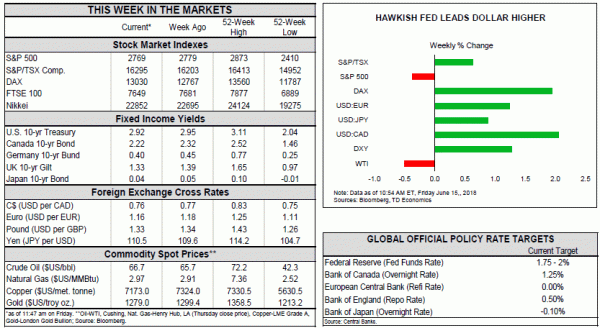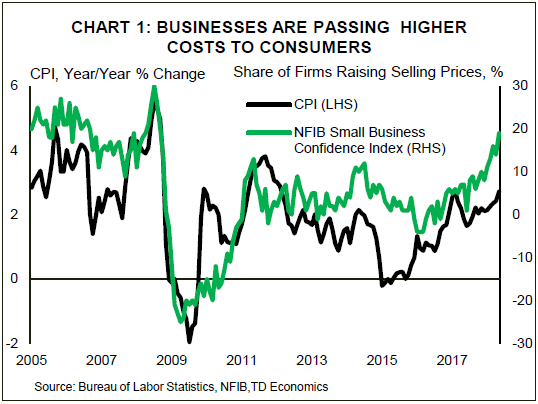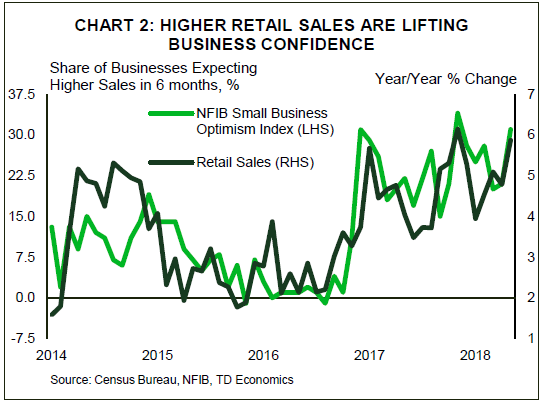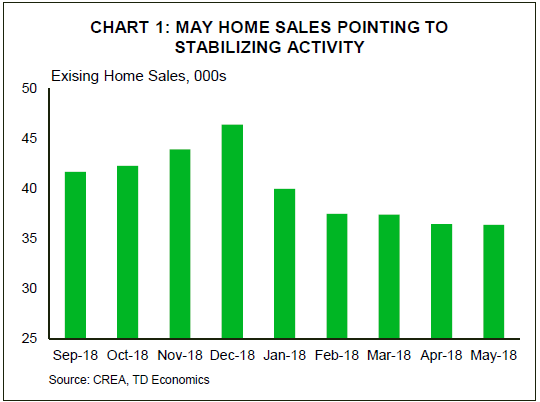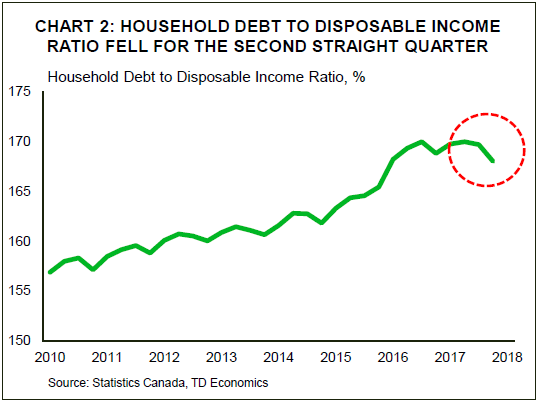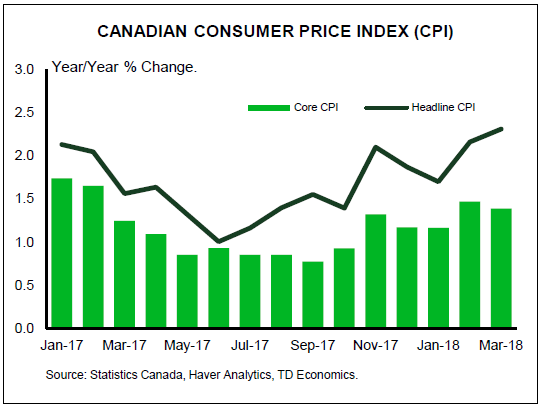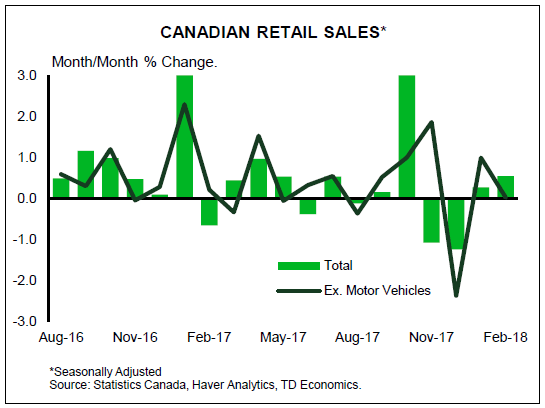U.S. Highlights
- The FOMC raised the fed funds target rate by 25 bp this week. Additionally, median expectations for the fed funds target rose to 2.4% (from 2.1%), suggesting that the committee was leaning toward two more rate hikes this year.
- Data corroborated the Fed’s hawkish view of the domestic economy and faster removal of monetary accommodation. The headline and core consumer price indexes rose by 0.2pp (m/m) apiece to 2.8% (y/y) and 2.2% (y/y), respectively. Additionally, retail sales surged by 0.8% in May and small businesses expressed increased confidence in the outlook.
- While things are honky-dory for now, the threat of trade wars continues to percolate. This week the administration announced 25% tariffs on $50 billion of goods imported from China, which prompted retaliatory action by China.
Canadian Highlights
- Trade tensions were front and centre in the recent G-7 summit in Quebec, weighing on the loonie by adding an additional layer of uncertainty to an already complicated backdrop and NAFTA negotiations.
- Canadian manufacturing had a weak start to the second quarter, with volumes falling 1.9% month-on-month in April. Fortunately, one-off factors were to blame with a bounce-back likely in the coming months, but the figures will nonetheless weigh on second quarter growth, tracking 2.7% currently.
- Housing resale activity stabilized in May after four monthly declines, while prices rose on the month. The better-than-expected report falls in-line with our view that housing markets will stabilize beginning in the second half of the year.
U.S. – Fed Raises Rate As Trade Risks Escalate
This was a busy week for soccer fans and investors alike. The former got treated to a kickoff of a month-long FIFA World Cup extravaganza in Russia, while the latter had a full docket of policy decisions from the Fed and the European Central Bank, as well as readings on inflation and retail sales and to close off the week an announcement of 25% tariffs on $50 billion of goods imported from China.
Tuesday’s inflation report got the ball rolling ahead of the FOMC rate announcement. As widely expected, inflation continued to gain traction in May. The headline and core consumer price indexes rose by 0.2pp (m/m) apiece to 2.8% and 2.2% (year over year), respectively. A strong economy, wage pressures and (now) tariffs will continue to push inflation measures higher in the coming months, particularly as businesses become more comfortable with passing higher costs to consumers (see Chart 1).
The Fed’s June rate hike looked like a done deal even before the inflation report, and indeed the FOMC raised the federal funds rate target by 25 basis points to a range between 1.75% and 2.0%. Details of the statement and the accompanying economic projections were insightful. Notably, the statement removed its forward guidance that the “federal funds rate is likely to remain, for some time, below levels that are expected to prevail in the longer run.” With committee member projections showing the federal funds rate rising above its anticipated “longer run” rate by 2019, this made sense. The Fed’s increased confidence in its rate hiking path was also illustrated in an edging up of the median expectation for the fed funds rate to 2.4% (from 2.1%) this year, implying two more rate hikes this year (one more than previously). During the press conference, Chairmen Powell also said that starting next year he will be holding a press conference following every FOMC meeting, a move likely aimed at freeing up Fed’s hands somewhat with respect to future rate changes.
The Fed’s view that economic growth is revving up was corroborated Thursday’s retail sales report. Spurred by tax cuts, job gains and rising incomes, American consumers have been on a tear for the last three months, and in May retail sales surged by 0.8% – double the expectations and the biggest jump in half a year. Helped along by a pickup in consumer spending, GDP growth is currently expected to surpass 4% (annualized) in the second quarter, and average 3% for the year as whole – the best result since 2005.
While the U.S. economy may be sizzling, there are risks on the horizon. As with tariffs on steel and aluminum, the recent tariff announcement on Chinese goods sparked a retaliatory action by China. Taken alone these tariffs are likely to present a modest drag on U.S. growth and modest lift to inflation (please see our recent report on U.S.-China tariffs). However, while direct impacts are modest, the hit to business confidence and supply chain disruptions could result in a more deleterious effect on growth, So far, financial markets have taken these skirmishes in stride, but a further escalation or full out trade war could bring this assumption into question.
Canada – Housing and Trade are the Economy’s Weakest Links
The recently imposed steel and aluminum tariffs by the U.S. government on its closest international allies have ignited a fresh bout of anxiety amongst world leaders, making for a mood that was anything but calm at the G-7 summit this past weekend. The meetings were dominated by trade issues, and the disagreement between the U.S. and other wealthy nations was laid bare by the fact that President Trump failed to endorse the joint meeting communique which concentrated on benefits that “free” and “fair” trade would bring. The event was not staid, with Prime Minister Trudeau calling the steel and aluminum tariffs “insulting” in a post-event conference, angering President Trump who then went on to insult the Prime Minister while toughening his trade stance. The events weighed on the loonie, adding an additional layer of uncertainty to an already complicated environment for trade. The global trade backdrop turned more sour this morning, with the U.S. government announcing some $50 billion in tariffs on Chinese exports. The additional uncertainty helped send oil prices sharply lower and weighed on equities.
The uncertain trade backdrop will not help Canada’s manufacturers, who already had a tough start to the second quarter. Volumes dropped by 1.9% in April, on weakness in both durables and nondurables. with the only silver-lining coming from the fact that it was related to one-off factors, offering hope for a bounce-back later in the quarter. The tough start to the quarter for manufacturers also caused us to pare back our expectations for second quarter activity, with GDP now likely to expand closer to the midpoint than the higher end of the 2% – 3% range, as previously anticipated.
Housing also took centre stage this week. Data on resale markets indicated unchanged activity in May (Chart 1) – the best performance so far this year. Other parts of the report were equally encouraging, with new listings rising for the 3rd time in 4 months and average prices ticking higher. Prices increased in the closely watched Vancouver and Toronto markets, with activity stable in the former and beginning to recover in the latter. Ultimately, the figures are consistent with our forecast of stabilization through mid-year and gradual recovery thereafter, supported by a relatively firm economic backdrop.
While they appear to have stabilized, existing home sales remain some 21% below December 2017 levels. Although the weaker resale activity has been a drag on economic growth, the Bank of Canada is likely to take solace in the fact that mortgage credit and overall household debt accumulation has moderated. National Balance Sheet Accounts for the first quarter indicated that mortgage borrowing dropped to its lowest level since 2014. Alongside rising incomes, this helped drive household debt-to-income ratio lower for the second quarter in a row. The share fell to 168% (Chart 2) with the moderating trend likely to be viewed as constructive by policymakers concerned about household debt loads.
Canada: Upcoming Key Economic Releases
Canadian Consumer Price Index – May
Release Date: June 22, 2018
Previous: 0.3% m/m nsa, 2.2% y/y
TD Forecast: 0.4% m/m nsa, 2.6% y/y
Consensus: 0.4% m/m nsa, 2.6% y/y
We expect headline CPI to rise to 2.6% y/y, reflecting a 0.4% m/m gain (0.3% seasonally adjusted). Gasoline prices will again be a boost, with retail prices at the pump up roughly 4% in May. A weaker CAD and the ongoing adjustment to minimum wage hikes also points to moderate gains in food prices.
Outside of food and energy, we expect subdued gains with continued mixed performance across categories. Importantly, the housing component of shelter (16.5% of CPI) is likely running at its peak as signaled by the sharp deceleration in new home prices. This is less of an upward pull from shelter costs going forward. In this report, we expect to see the gap between exclusion-based core indexes (CPIX and CPIXFE) and BoC core measures to close further, with the latter stabilizing at 2.0% and the former moving marginally higher. Looking ahead, CPI is likely running near its peak, holding at 2.6% y/y in June and decelerating gradually toward 2% through year end.
Canadian Retail Sales – April
Release Date: June 22, 2018
Previous: 0.6%, ex-auto: -0.2%
TD Forecast: -0.2%, ex-auto: 0.3%
Consensus: 0.0%, ex-auto: 0.7%
TD looks for retail sales to dip 0.2% in April on a pullback in motor vehicles. Retail auto sales have risen by 5% since November despite a significant slowdown in the housing market, and a further deceleration in credit growth suggests some giveback is likely in April. Ex-auto sales should post a modest advance on the strength of gasoline prices, which rose by 6.8% m/m and will provide a tailwind to sales at the pump. However this will be offset by the impact of severe weather which will weigh on building materials. Real retail sales should land near the nominal print given the muted increase in seasonally adjusted consumer prices. While this will start the second quarter on a soft note, the 0.9% handoff from March will help to anchor Q2 spending.




